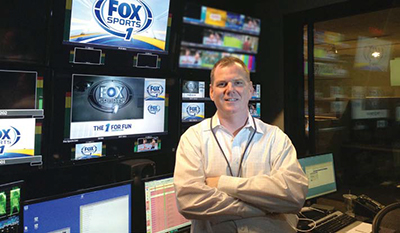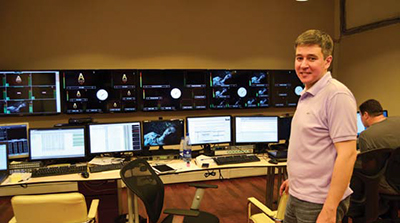More Than Just a ‘Channel in a Box’

Fox recently updated the playout infrastructure at its Los Angeles broadcast center with Harmonic’s Spectrum ChannelPort branded channel playout system in preparation for the August launch of its Fox Sports 1 Network.
NEW YORK—Facing state and federal funding cuts, local PBS station group Commonwealth Public Broadcasting in Richmond, Va., had to make some tough changes. The group had switched from analog to digital in 2007, but was still operating on a tape-based workflow. By 2011, with the recession not quite yet in the rear view mirror, the workflow was no longer working. Commonwealth concluded that to survive, it had to do more with less.
Commonwealth, which operates three public television channels—WCVE-TV and WCVW in Richmond and WHTK in Charlottesville, Va.—under the umbrella Community Idea Stations, replaced its master control system with a Snell ICE CiaB solution. The company had selected Snell as the primary vendor for its basic automation and routing infrastructure when it went digital, Spiller said, making ICE a plug-and-play option for the broadcaster.
“Looking down the road we saw major funding cuts at the state and federal levels,” said Mark Spiller, vice president of engineering and digital operations at Commonwealth. “It was a cost-cutting measure that we had to take; Channel-in-a-box afforded us the ability to run our stations without 24-hour manpower.”
SINGLE AND INTEGRATED
In an environment of station group consolidation, audience segmentation, channel proliferation, escalating costs and shifting revenue streams, broadcasters, networks and system operators alike are looking to automate playout as a means of cutting costs, simplifying workflows and even, as in cases like Commonwealth’s, protecting investments.
Notable among those using CiaB systems is Fox Broadcasting, which, in preparing to launch Fox Sports 1, its answer to ESPN, on Aug. 17, converted the entire playout infrastructure at its Los Angeles broadcast center to a Harmonic ChannelPort solution. With support for up to four channels per rack unit, Fox is running 14 channels on the system.

Moscow-based Amedia, a leading Russian TV and Film production company, recently launched two channels in the country based on the Harris Broadcast Versio integrated playout solution. Channel-in-a-box systems collapse all the moving parts of playout, such as switchers, graphics, servers, audio, routing and channel branding, into a single integrated software application that runs on generic IT-based hardware. Globally, the CiaB market is expected to grow 27.42 percent a year (CAGR) to $146 million in 2017 from $43.4 million in 2012, according to a study by Transparency Market Research, Albany, N.Y.
Get the TV Tech Newsletter
The professional video industry's #1 source for news, trends and product and tech information. Sign up below.
“Everybody is looking at them; you can’t visit any customer that hasn’t given it some thought,” said Andy Warman, director of product management, production and playout at Harmonic, San Jose, Calif., which offers the Spectrum ChannelPort Ciab solution. “They’ve all given it consideration.”
Notable among those using CiaB systems is Fox Broadcasting, which, in preparing to launch Fox Sports 1, its answer to ESPN, on Aug. 17, converted the entire playout infrastructure at its Los Angeles broadcast center to a Harmonic ChannelPort solution. With support for up to four channels per rack unit, Fox is running 14 channels on the system.
Other known CiaB users include ABC Owned Television Stations, which earlier this year replaced master control at its eight stations with Montreal-based Miranda Technologies’s iTX channel-in-a-box (CiaB) solution. In another master control makeover, New York State’s nine PBS stations banded together to form a single entity, Centralcast LLC, which has partnered with Evertz, Burlington, Ontario, to create a turnkey playout system for 35 television channels across New York and New Jersey.
RJ Communications, a provider of broadcast engineering services in Albuquerque, N.M., is using Flower Mound, Texas-based Rushworks’ A-List playout system to help operate four stations that collectively have 13 channels. And some nine Clear Channel stations are running on Florical Systems’ Acuitas playout system, which was co-developed by the two companies in a special partnership before Clear Channel acquired the vendor, based in Gainesville, Fla.
ECONOMIES OF SCALE
As at Commonwealth, the business driver across the board, whether an organization is seeking to launch new channels or reduce costs and complexity by replacing master control, is achieving economies of scale.
“The No. 1 thing customers are after is efficiency,” said Joe Zaller, a media industry consultant and founder of market research firm Devoncroft Partners, Coronado, Calif. “So vendors are collapsing a lot of functionality into these products.”
In fact, some CiaB systems are so packed with functionality, vendor marketing managers shudder at calling them a “channel in a box,” preferring integrated channel or integrated playout instead. While they like to emphasize the benefits of a single-server solution, they also object to a name they say oversimplifies what it takes to squeeze that amount of automation and functionality onto one video server.
“I hate that term; it’s so much more than that,” said Tim Mendoza, director of playout at Harris Broadcast in Denver, said of the CiaB label. “It changes how you do graphics, workflows, how storage is managed. It’s a totally different paradigm than throwing up a $6,000 box and running a channel.”
Similarly, Harmonic’s Warman noted that integrated playout significantly changes operations. “Things that took hours now take only a few minutes,” he said. “It provides a real, practical savings of space, power and time, and you get functionality that was very difficult to achieve previously.”
As the systems become more sophisticated, and more functionality is compressed into a single server, the lines between production automation and playout automation are blurring, Zaller said. While channel in a box systems were developed originally to do just what the name implies— launch a channel with a relatively simple, low-cost solution—the need to operate more efficiently is driving organizations to look at the systems as replacements for master control as well as to get new channels on-air.
“Consumers will go for niche channels, but it’s not practical to stand up $250,000 worth of equipment for ‘The Realtor Channel,’” Warman said. “So you spend $50,000 to $100,000, and it looks and feels like the old way. Now, integrated playout is coming into mainstream because of cost pressures.”
Harris Broadcast’s Versio playout server, as Mendoza describes it, sounds uncannily like a miniature version of the company’s Nexio master control platform. “We took that video server technology; the technology from our graphics engines; our automation solutions, which run 700 clients; and our master control tech, and have integrated it all into Versio,” he said.
Introduced at IBC 2012, Versio has been installed at about 15 different client sites worldwide, Mendoza said. So how does the company, which was recently broken off from Harris Corp. and acquired by a private investment group, keep from cannibalizing its own core product line? “We are not focused on protecting one product line at the expense of the customer—we’re focused on what they want and making it easier for them to launch new channels,” Mendoza said. “I’m convinced if you do that, your sales will work out.”
The term channel in a box doesn’t just agitate vendor marketing managers; it spooks personnel working in master control. Converting to an integrated playout solution will inevitably result in a staff reduction. At Commonwealth, for example, the switch to integrated playout eliminated three operators.
“We were able to take the folks who stayed and redirect their job descriptions to work into the ICE unit’s workflow,” Spiller said.
To at least some extent, job losses related to automating playout may be mitigated by new job creation. Because they enable cost-conscious broadcasters to get new channels on the air quickly—the original intent behind the boxes—they can, at least theoretically, help grow the job market via increased channel proliferation.
And for some customers, like Commonwealth and its Community Idea stations, they help guarantee the survival of the operation and, thus, the remaining jobs.
“People are really dedicated here, so when making big changes like we did... everyone is gung-ho to improve the signal,” Spiller said. “It may change a few jobs and what [employees] were used to, but the air signal looks way better, and you’ve improved and have more ways to display wares than you did in the analog world.”
